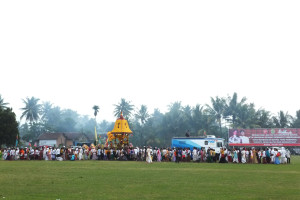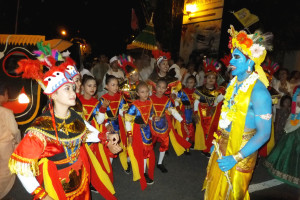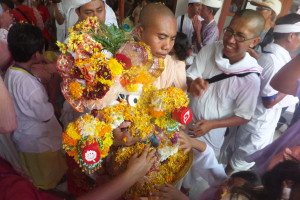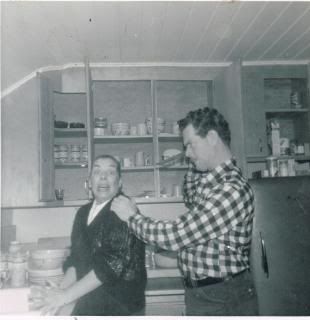(Kadamba Kanana Swami, 08 June 2014, Stockholm Sweden, Sunday Feast, Srimad Bhagavatam 1.5.14)
 When Srila Prabhupada came to Germany, he met Sacinandana swami’s father. His son had just become a devotee and Sacinandana Maharaj’s father asked a question to Prabhupada,”How can a crocodile survive in the Rhine?” Srila Prabhupada’s answer was, “It is not required to wear this dress. One can also be in plain clothes and be a devotee.” So, there are many quotes on this story, some a little dramatic. Then Sacinandana Maharaj’s father was very impressed and said, “Oh, your guru is very intelligent.” Because Prabhupada understood that question, ‘A crocodile in the Rhine!’
When Srila Prabhupada came to Germany, he met Sacinandana swami’s father. His son had just become a devotee and Sacinandana Maharaj’s father asked a question to Prabhupada,”How can a crocodile survive in the Rhine?” Srila Prabhupada’s answer was, “It is not required to wear this dress. One can also be in plain clothes and be a devotee.” So, there are many quotes on this story, some a little dramatic. Then Sacinandana Maharaj’s father was very impressed and said, “Oh, your guru is very intelligent.” Because Prabhupada understood that question, ‘A crocodile in the Rhine!’
We see that many spiritual traditions in the world have two sides to it. One monastic side, a priestly class, that wear some kind of uniform, some dress standing for spirituality that distinguishes them from the world and gives them their spiritual identity. The other is the secular feature. So, I think that the Krsna West approach to Krsna consciousness is going to be the secular feature of the movement, and best, and has always been because it is not a new invention. It has already been there, now it is just that the idea is formalised a bit more. You already know about the Krsna West because most of the time you are dressed in the Krsna West uniform, so the secular aspect.
Now the secular aspect of Krsna consciousness – Krsna consciousness is a transplant, it is ‘A crocodile that has been put into the Rhine’. It is another culture, not a tradition. The dress, well what is our idea of the Vedic dress? The kurta as Hridayananda Maharaj rightly points out, is a Muslim invention and the cholis are not exactly Vedic. But saris and some sort of dhotis or whatever, that sort of goes back to a more traditional thing. The chaadhar – very traditional! So it was born out of another culture. The clothes, they come out of a culture. This was born out of a culture that had tried to regulate sexual activity and therefore was not ‘putting it’ some much out into the public. Therefore, certain parts of the bodies were nicely covered. This (sannyasa) cloth is different! Tight jeans kind of displays whatever is there, right! Or when ladies walk around with tight jeans and tight t-shirts with nothing under it and chant Hare Krsna at the same time! Hare Krsna is nicely chanted but the dress is of a different culture, a culture that deals with sexuality in a different way.
 Now, when I brought up this argument to Hridayananda Maharaj, he pointed out, “Yes, I am not saying we should wear those kinds of clothes, I am talking about wearing sattvic Western clothes, something in the mode of goodness.” All right, nice, better than those other clothes which incite passion. But I can imagine that many people in the world could relate much easier to Krsna consciousness if it was not in such an oriental religious guise; you know, if it was a little more integrated. For those people, it is good. But I also think that as all traditions of the world show the monastic aspect of spiritual tradition, there are those people who are full time dedicated to it, without having to compromise with society. They are withdrawn from society. They are spending all their time with their spirituality and they become the spiritual leaders, the inspiration for the secular practitioners. So, I think that is, in my estimation, the best we can expect from Krsna West with all due respect to the efforts that are out there. I think it is nothing new, it sounds more dramatic than it is.
Now, when I brought up this argument to Hridayananda Maharaj, he pointed out, “Yes, I am not saying we should wear those kinds of clothes, I am talking about wearing sattvic Western clothes, something in the mode of goodness.” All right, nice, better than those other clothes which incite passion. But I can imagine that many people in the world could relate much easier to Krsna consciousness if it was not in such an oriental religious guise; you know, if it was a little more integrated. For those people, it is good. But I also think that as all traditions of the world show the monastic aspect of spiritual tradition, there are those people who are full time dedicated to it, without having to compromise with society. They are withdrawn from society. They are spending all their time with their spirituality and they become the spiritual leaders, the inspiration for the secular practitioners. So, I think that is, in my estimation, the best we can expect from Krsna West with all due respect to the efforts that are out there. I think it is nothing new, it sounds more dramatic than it is.
I am a sannyasi by vow, the vows are strict! I find that if we just dressed in jeans and in regular clothes then I would find that a burden. I find that if I would just let my hair grow and a little beard, I would sort of lose a certain amount of self-discipline. I find that even every once in a while when I shave my head, it reconfirms my self-discipline. So, I find I get benefits from all these practises on a personal level and therefore I am quite convinced that it is beneficial!

 Of the nine processes of devotional service, the most important is to always chant the holy name of the Lord. If one does so, avoiding the ten kinds of offenses, one very easily obtained the most valuable love of Godhead.
Chaitanya Caritamrta Antya Lila 4.71 Read more ›
Of the nine processes of devotional service, the most important is to always chant the holy name of the Lord. If one does so, avoiding the ten kinds of offenses, one very easily obtained the most valuable love of Godhead.
Chaitanya Caritamrta Antya Lila 4.71 Read more ›  Of the nine processes of devotional service, the most important is to always chant the holy name of the Lord. If one does so, avoiding the ten kinds of offenses, one very easily obtained the most valuable love of Godhead.
Chaitanya Caritamrta Antya Lila 4.71 Read more ›
Of the nine processes of devotional service, the most important is to always chant the holy name of the Lord. If one does so, avoiding the ten kinds of offenses, one very easily obtained the most valuable love of Godhead.
Chaitanya Caritamrta Antya Lila 4.71 Read more › 



 By chanting Krishna’s names, one will be transferred to the supreme planet, Krishnaloka, without a doubt.
Bhagavad-gita 8.7,
Srila Prabhupada
By chanting Krishna’s names, one will be transferred to the supreme planet, Krishnaloka, without a doubt.
Bhagavad-gita 8.7,
Srila Prabhupada  Once upon a time there lived a group of monks in an old monastery in the forest, near to a large city.
In years gone by the religious order had been so esteemed, with positions in the royal court, so much so that no person would ever pass by one of their temples or ashrams without visiting to pay most humble obeisances, to offer foodstuffs and donations and to prostate themselves in front of the deities.
But for a very long time now the religious order had declined, many people who lived in the Cities, towns and villages were so caught up with pleasing themselves that they had forgotten all about the monks. The only devotees left were these scattered old monks, ageing and diseased. And the monks in each monastery were considered by each other to be the last of their order.
Once upon a time there lived a group of monks in an old monastery in the forest, near to a large city.
In years gone by the religious order had been so esteemed, with positions in the royal court, so much so that no person would ever pass by one of their temples or ashrams without visiting to pay most humble obeisances, to offer foodstuffs and donations and to prostate themselves in front of the deities.
But for a very long time now the religious order had declined, many people who lived in the Cities, towns and villages were so caught up with pleasing themselves that they had forgotten all about the monks. The only devotees left were these scattered old monks, ageing and diseased. And the monks in each monastery were considered by each other to be the last of their order. 

 Madhuvisa prabhu has given a beautiful class in Los Angeles just a few days ago. This is the video recording by Mayapur.tv
Madhuvisa prabhu has given a beautiful class in Los Angeles just a few days ago. This is the video recording by Mayapur.tv  Vinode Vani devi dasi first met the devotees in 1970 while working for college credit at the University of California, San Francisco Hospital. She used to walk past the Hare Krishna Temple every day on her way to work and gave donations to the Harinama party in downtown San Francisco, receiving Back to Godhead magazines and sticks of incense in exchange. Being interested in Buddhism at the time, she did not visit the Temple, as she had heard that the devotees were into feasting - she was into fasting! In her hometown of Houston, TX, Vinode Vani prabhu again received BTGs, this time from Dharma-Bhavana das who was going door-to-door. Encountering BTGs once again sparked a fire in her heart, leading her to read every BTG in the University of Houston library. Within days, she went to the Houston Temple, where she met Ananga Manjari devi dasi and many other devotees. After visiting the temple for a week, she shaved up her husband and they moved into the Temple in December 1971. By early summer 1972, they were initiated.
Vinode Vani devi dasi first met the devotees in 1970 while working for college credit at the University of California, San Francisco Hospital. She used to walk past the Hare Krishna Temple every day on her way to work and gave donations to the Harinama party in downtown San Francisco, receiving Back to Godhead magazines and sticks of incense in exchange. Being interested in Buddhism at the time, she did not visit the Temple, as she had heard that the devotees were into feasting - she was into fasting! In her hometown of Houston, TX, Vinode Vani prabhu again received BTGs, this time from Dharma-Bhavana das who was going door-to-door. Encountering BTGs once again sparked a fire in her heart, leading her to read every BTG in the University of Houston library. Within days, she went to the Houston Temple, where she met Ananga Manjari devi dasi and many other devotees. After visiting the temple for a week, she shaved up her husband and they moved into the Temple in December 1971. By early summer 1972, they were initiated.  Hare Krishna, Hare Krishna, Krishna Krishna, Hare Hare/ Hare Rama, Hare Rama, Rama Rama, Hare Hare. In Kali-yuga, if this Vedic maha-mantra is chanted regularly and heard regularly by the devotional process of shravanam kirtanam, it will purify all societies, and thus humanity will be happy both materially and spiritually.
Srimad Bhagavatam 4.18.14,
Srila Prabhupada.
Hare Krishna, Hare Krishna, Krishna Krishna, Hare Hare/ Hare Rama, Hare Rama, Rama Rama, Hare Hare. In Kali-yuga, if this Vedic maha-mantra is chanted regularly and heard regularly by the devotional process of shravanam kirtanam, it will purify all societies, and thus humanity will be happy both materially and spiritually.
Srimad Bhagavatam 4.18.14,
Srila Prabhupada. 




















 Devi Citralekha ji's, a devoted to Krishna soul, visit to Mayapur.
Devi Citralekha ji's, a devoted to Krishna soul, visit to Mayapur.  Indradyumna Swami: Polish Woodstock came and went so quickly! The organisers say 800,000 people attended. We chanted, danced and distributed prasadam ( 126,000 full plates ) until we could no longer stand on our two feet. Kirtans went on until 4 am each morning in a tent filled constantly with hundreds of people. Many thanks to the 700 devotees from Russia, Ukraine and all over Europe who gave their hearts and souls to sharing the blissful life of Krsna consciousness with hundreds and thousands of festival goers. Certainly the lives of those people will never be the same, and neither will ours. It was a dream come true. All glories to Srila Prabhupada!
Indradyumna Swami: Polish Woodstock came and went so quickly! The organisers say 800,000 people attended. We chanted, danced and distributed prasadam ( 126,000 full plates ) until we could no longer stand on our two feet. Kirtans went on until 4 am each morning in a tent filled constantly with hundreds of people. Many thanks to the 700 devotees from Russia, Ukraine and all over Europe who gave their hearts and souls to sharing the blissful life of Krsna consciousness with hundreds and thousands of festival goers. Certainly the lives of those people will never be the same, and neither will ours. It was a dream come true. All glories to Srila Prabhupada!